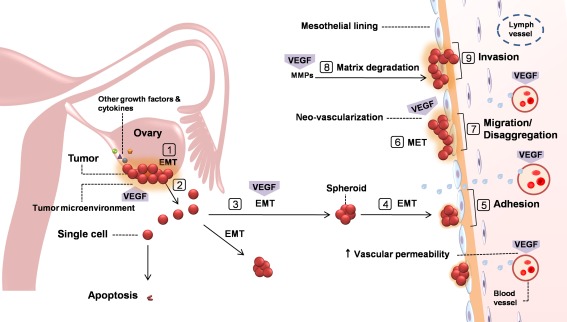Fig. 2.
A proposed model for intraperitoneal dissemination of ovarian cancer [173, 174] with focus on the role of VEGF. Primary tumors are generally confined to the ovaries. To metastasize, tumor cells undergo epithelial–mesenchymal transition (EMT) to attain motility 1 Subsequently, ruptured tumor sheds malignant cells into the peritoneum 2 where they often form spheroids to survive. 3 Spheroids undergo changes into invasive mesenchymal phenotype to maintain survival and motility. 4 These cellular aggregates are transported throughout the peritoneal cavity by normal peritoneal fluid and then adhere to and implant on the peritoneum and mesothelial linings of pelvic and abdominal organs 5, where they undergo a reverse transition (MET) 6 and disaggregation 7 to initiate metastatic growth. Through the activity of MMPs, matrix degradation occurs 8 and invasive tumor cells infiltrate the mesothelial lining and the extracellular matrix 9. Cytokines and growth factors, such as VEGF, TNF-α, IL-6, IL-8, and bFGF, contribute to EMT and invasiveness of spheroids via autocrine and paracrine loops. VEGF is also significantly involved in different steps of the process, including primary tumor angiogenesis, neovascularization at newly seeded sites, MMP-mediated matrix degradation, and malignant ascites formation

